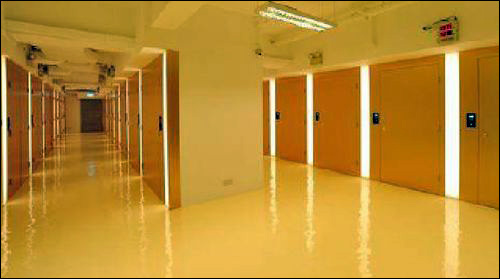Beautiful Mind, an art storage and restoration company in Hong Kong, can assure art owners of the security of their paintings, sculptures, tapestries and porcelain, thanks to an automated solution consisting of passive high-frequency (HF) RFID tags (which provide access control to storage units), passive ultrahigh-frequency (UHF) tags and readers (which track each piece of art) and ZigBee wireless sensors (which monitor the conditions within each storage unit). The system, including the tags, readers, software and installation, was provided by EPC Solutions Taiwan.
The 10,000-square-foot building, located in Hong Kong’s North Point section, houses 23 climate-controlled storage units in which works of art can be stored, as well as five VIP storage rooms. Each storage unit and VIP room is equipped with an HF RFID reader at the doorway, to manage who accesses that area. In addition, a UHF portal tracks individual pieces of tagged artwork as they leave the unit or room, while ZigBee sensors provide information regarding temperature and humidity. EPC Solutions Taiwan software, residing on Beautiful Mind’s database, manages all collected data. EPC Solutions also manufactured the HF readers, as well as the EPC and HF RFID tags.

The facility provides three services related to fine art: professional art restoration, art education, and storage for clients such as collectors and galleries. “The initial thought, when I planned this space and storage, was to make sure the environment was built specifically for fine-art collectors’ use,” says Vinci Chang, Beautiful Mind’s president. She sought a solution that would allow collectors to enter and exit their units, while remaining assured that artwork—which could be of high value—was always safe against theft, loss or damage from improper temperature or humidity levels. To ensure that this would be the case, she says, she realized the solution “would have to have advanced technology for storage control and maximum security.”
To access a unit or VIP room, Beautiful Mind’s employees and clients (owners of artwork stored within the units) are issued 13.56 MHz passive HF RFID tags complying with the ISO 14443A standard. Each staff member wears a badge with a built-in HF tag, while clients carry HF RFID cards similar to a credit card. In either case, an individual presents his or her RFID tag to the reader connected to the door lock. The software will not unlock the doors unless both an employee and a client are present. If the software successfully captures and confirms both an RFID tag with a unique ID number corresponding to the proper unit client, and an employee’s own ID number, the door unlocking mechanism will be triggered, according to T.H. Liu, EPC Solutions Taiwan’s president. The software also stores a record of that event.When fine art is received for storage in one of the units, a passive EPC Gen 2 UHF RFID tag custom-made by EPC Solutions Taiwan, with a built-in Alien Technology Higgs-3 chip, is attached to that artwork, and the tag’s ID number is linked in the software to details regarding that piece of art, its owner and the storage unit in which it will be stored. Beautiful Mind has installed a total of 37 UHF interrogators to read the tags on that artwork as it moves throughout the building. An Alien ALR 9650 reader is installed at the doorway of each storage unit and VIP room, with an additional reader located inside each of the five VIP rooms. In addition, one interrogator is located at the main doorway, two are in a restoration studio and one is in an educational area. Those readers not mounted at storage unit doorways are Alien Technology ALR 9900 models.
In the event that artwork is removed from storage to be serviced in the restoration studio, or to be exhibited in the educational area, the readers will capture the ID numbers of those tags, and the software will calculate the artwork’s location based on that reading, as well as the date and time at which the art is returned to its storage unit.
The RFID technology built into VIP rooms is still being deployed, and is expected to be taken live in June 2013. Clients using VIP rooms—which measure approximately 2 meters by 5 meters (6.6. feet by 16.4 feet)—prefer to have an added level of security, the company reports, by knowing what is in their storage units in real time, as opposed to only when artwork is moved into or out of the room. To make this possible, each of the five VIP rooms will have a cable antenna, similar to a coaxial cable, running under every shelf within the storage unit. The artwork is stored on shelves immediately above the cable antenna, thereby making it possible to read all tags within the room in real time. That data is forwarded to the Beautiful Mind server, where it can then be accessed by the VIP customer. The client will be able to simply access Beautiful Mind’s Web site, key in a password and view the artwork’s inventory listing, as well as view inside the VIP room via a camera.
Each storage unit and VIP room also includes a Sensingtek ZigBee sensor that measures air temperature and humidity levels, and transmits that data via 2.4 GHz to a single gateway receiver cabled into the back-end system in the restoration room. The EPC Solutions software not only collects data related to temperature and humidity readings, but can also issue an alert (such as a text message) in the event that conditions within any unit fall outside of acceptable parameters.
The RFID system was taken live in July 2012, with the exception of the VIP tracking solution, which is anticipated to be completed by June of this year. To date, Chang says, the system has provided her with the ability to know that artwork is secure, which benefits both Beautiful Mind and its clients.

